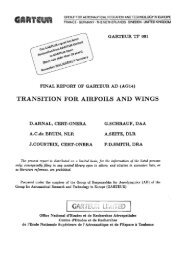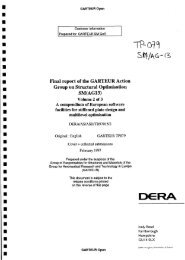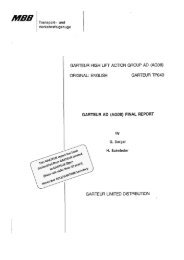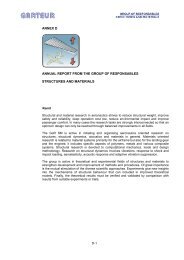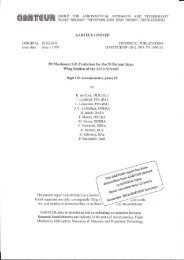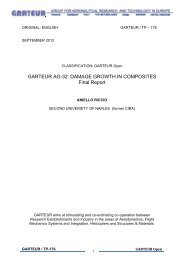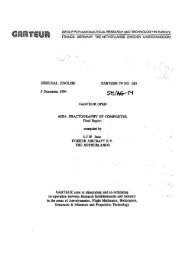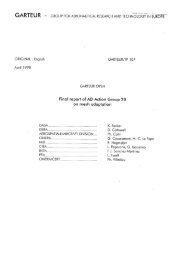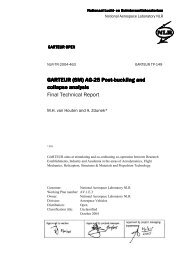Cadmium Substitution - garteur
Cadmium Substitution - garteur
Cadmium Substitution - garteur
You also want an ePaper? Increase the reach of your titles
YUMPU automatically turns print PDFs into web optimized ePapers that Google loves.
GARTEUR LIMITED<br />
D.3 Results and discussion<br />
D.3.1<br />
D.3.1.1<br />
Accelerated corrosion tests<br />
Daimler Benz Airbus Aerospace<br />
The results of neutral salt tests are summarised in table D1. The blocks were inspected<br />
on a weekly basis for evidence of rusting on the bolt heads. Data presented in table D1<br />
indicate that the four substitute coatings examined were less prone to rusting under<br />
these conditions than the electrodeposited cadmium control. The most promising coating<br />
was the Delta-tone/Delta coat which showed no evidence of rusting during the exposure<br />
period.<br />
D.3.1.2<br />
Fokker<br />
Metallographic examination of the aluminium alloy blocks after testing showed that<br />
corrosive attack had occurred in the countersink when cadmium plated bolts were used.<br />
No evidence of corrosion was found in the countersinks when there was contact with<br />
zinc-nickel and zinc-cobalt-iron plated bolts.<br />
D.3.2<br />
Natural exposure trials<br />
During the 10 month exposure period at the Schiphol test site no evidence of corrosion<br />
attack was observed.<br />
D.3.3<br />
Electrochemical measurements<br />
In the first part of this study, the current flow between different coatings and two<br />
aerospace aluminium alloys was monitored. In all cases, some galvanic current flow was<br />
detected indicating that the coatings were interacting galvanically with the two alloys.<br />
Curves showing the variation in galvanic corrosion current with time for each of the<br />
coatings coupled to 2014-T6 and 7075-T6 aluminium alloys are reproduced in figures D4<br />
and D5 respectively. In most cases, the current was found to flow from the coating to the<br />
aluminium alloys. The exceptions were electrodeposited zinc-nickel alloy coating and<br />
Delta-tone where current reversal effects were seen after coupling periods of over 100<br />
hours. Tables D3 and D4 give the average current densities recorded for each of the<br />
coatings. In general, higher galvanic current values were observed for the more active<br />
zinc base coatings than the less active aluminium base coatings.<br />
The coupling of a metal coating with an aluminium alloy can cause corrosion of the<br />
aluminium alloy even if the coating is a sacrificial one. This occurs as a result of the build<br />
up of alkaline conditions on the aluminium alloy surface, which unlike in the case of steel<br />
which is stable at high pHs, can lead to damaging pit attack. In the second part of the<br />
work, therefore, the effect of galvanic coupling on the corrosion rate of the aluminium<br />
alloys was determined.<br />
The galvanic corrosion rate of the aluminium alloy, R g was calculated from the following<br />
expression,<br />
R g = R a - R o --------------------- (D1)<br />
where R o is the self corrosion rate and R a is the total corrosion rate of the aluminium<br />
alloy.<br />
The corrosion rates, R g, , of the two aluminium alloys were slightly increased by coupling<br />
with cadmium plating as indicated in tables D3 and D4.<br />
Page 72<br />
GARTEUR SM/AG17 TP128




